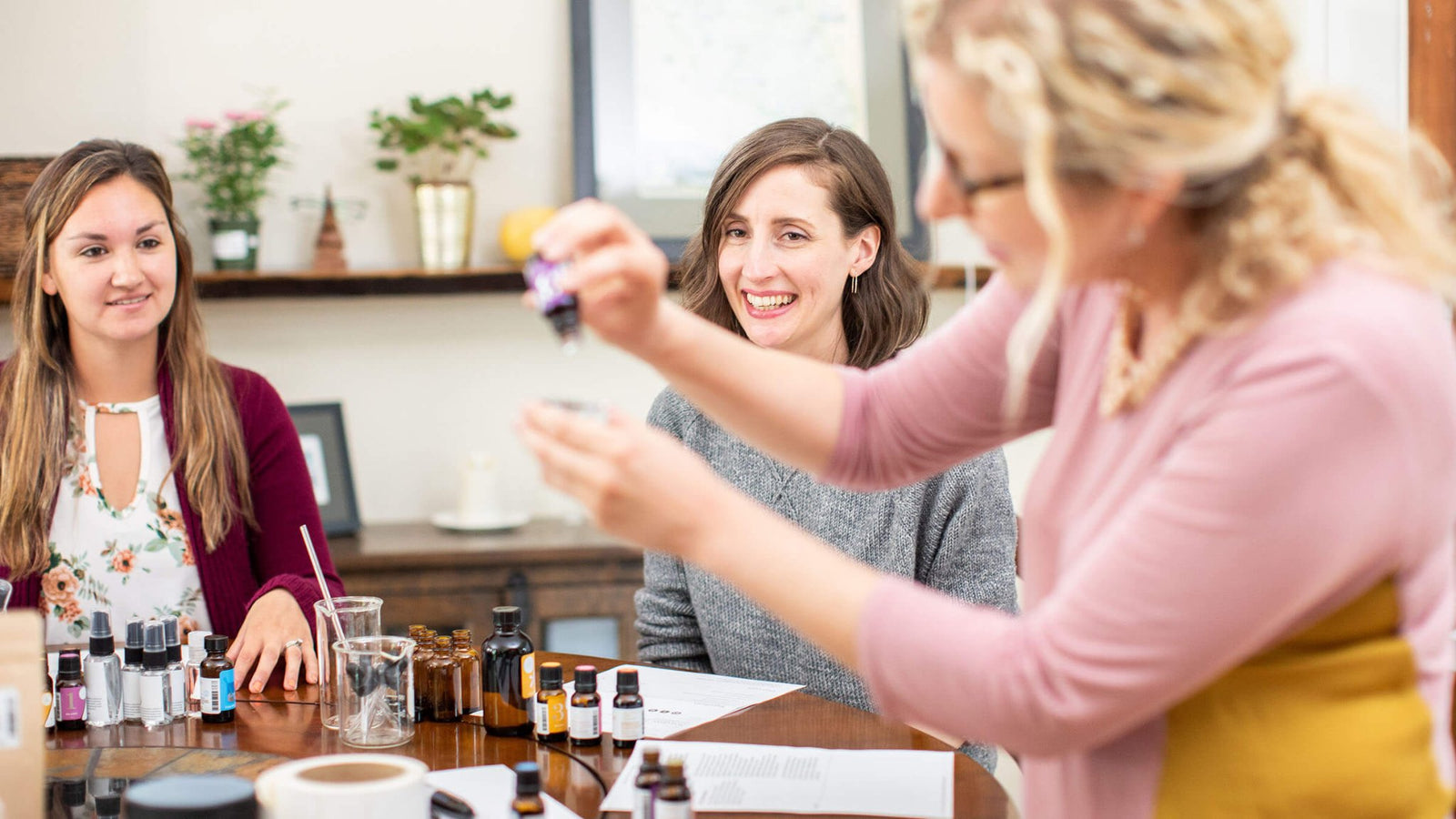Professional essential oil safety

Professional essential oil safety
These guidelines are from the book Essential Oil Safety by Robert Tisserand and Rodney Young, and from our own Certified Aromatherapists’ decades of experience working with essential oils.
While these guidelines can help you blend safely, remember to always treat essential oils with respect. Seek medical help if serious irritation or other negative reactions persist.
1. Dilute essential oils for skin application.
Essential oils are highly concentrated plant essences.
For context, it can take from 30 to 50 roses to produce just one drop of rose essential oil. That means that a small 5 ml bottle (which can hold approximately 125 drops), contains the essence of between 3,750 and 6,250 roses.
Exposing your skin to such a high concentration of plant material calls for extreme respect and care.
Diluting your blends from 1% to 3% is a safe practice, while still offering all the benefits of your essential oils.
- 1% – 5 to 6 drops in 1 oz (30 ml/28 g) of carrier
Best for long-term use, children, or sensitive people. - 2% – 10 to 12 drops in 1 oz (30 ml/28 g) of carrier
Best for general use by healthy adults. - 3% – 15 to 18 drops in 1 oz (30 ml/28 g) of carrier
Best for addressing short-term, acute issues.

2. Avoid using irritating oils in blends for direct inhalation or sensitive skin application.
Some essential oils can seriously irritate mucous membranes, such as those with high amounts of the phenol or aldehyde chemical families.
A few examples are the phenol-rich: Clove Bud Oil (Syzygium aromaticum/Eugenia caryophyllata) and Thyme ct Thymol Oil (Thymus vulgaris ct thymol), and the aldehyde-rich Melissa Oil (Melissa officinalis) and Lemongrass Oil (Cymbopogon citratus).
Use caution when blending with these oils.
3. Blend at lower dilutions for children.
Babies and children are very sensitive, and their systems are more responsive than those of adults. Little ones can easily become overwhelmed by essential oils.
While there’s no universally agreed age when it’s right to start using essential oils for kids, caution makes sense. These are our suggestions based on research and experience.
For children between 5 and 12 years old, blend with a low 1% dilution.
For younger children and babies, try leaving out the essential oils. Hydrosols (aromatic waters), carrier oils and butters, and aloe vera gel are often enough to support them.
You can also diffuse essential oils around small children and babies, making sure to use very gentle oils that aren’t known to cause irritation. Keep the room well-ventilated, and only run your diffuser for about 15 minutes at a time.
Always keep your essential oils out of children’s reach (Lots of oils smell good, and kids like to put things in their mouths!).
For more information read our blog, Essential Oils and Kids: What You Need to Know
essential oils and kids4. Use caution when blending for pregnant and breastfeeding women.
During pregnancy, both mother and baby are in a sensitive place.
Blending at a low 1% dilution is a safe, cautious practice that respects them both.
5. Be cautious when using essential oils that may cause a phototoxic reaction.
Avoid UV light (sunlight or tanning beds) for up to 18 hours after applying phototoxic essential oils to your skin. These oils can cause severe reactions in sunlight.
Some phototoxic oils can still be used for topical application as long as they’re appropriately diluted:
- Angelica Root Oil (Angelica archangelica) Dilute at 0.8%
- Bergamot Oil (Citrus bergamia) Dilute at 0.4%
- Bitter Orange Oil (Citrus sinensis) Dilute at 1.25%
* Sweet Orange Oil (also Citrus sinensis) is NOT phototoxic. - Grapefruit Oil (Citrus paradisi) Dilute at 4%
- Laurel Leaf Absolute (Laurus nobilis) Dilute at 2%
- Lemon Oil (Citrus limon) Dilute at 2%
- Lime Oil, cold-pressed (Citrus aurantifolia) Dilute at 0.7%
* Distilled Lime Oil (also Citrus aurantifolia) is NOT phototoxic. - Mandarin Leaf Oil (Citrus reticulata) Dilute at 0.17%
* Mandarin Oil cold-pressed from the fruit rind (also Citrus reticulata) is NOT phototoxic.
6. Do not drop essential oils in your eyes, ears, or other orifices.
Essential oils are way too strong for this! Even the fumes may irritate your eyes. Use caution when applying essential oil blends to your face.
If you do get essential oil in your eye, quickly wash your hands with soap and water. Put carrier oil (such as jojoba) on a paper towel, and press it over your eye. Do this several times to help draw the essential oils to the carrier, and out of your eye.
Flushing with saline solution also helps.
7. People with asthma, allergies, or chemical sensitivities should use essential oils cautiously.
It’s good practice to have sensitive people smell the lid of an essential oil before using it in a blend for them.
As they smell the lid, ask them if their chest feels tight, or they’re experiencing any other negative reactions from the aroma. If not, go ahead and blend with it at a low, cautious dilution.
8. Be cautious when blending for cancer patients.
Tisserand and Young recommend avoiding essential oils for 1 week up to 1 month following chemotherapy or radiotherapy.
Rhiannon Lewis (a widely respected aromatherapy educator and editor of the International Journal of Clinical Aromatherapy) has suggested comforting anxiety and nausea with essential oil inhalers or diffusers.
9. Do not apply essential oils directly to the fur or skin of animals.
Animals are highly sensitive and must never be forced to accept essential oils which may be toxic to them, or too strong for their systems. On the same note, never put essential oils into an animal’s food.
Using essential oils for animals requires specific training.
Professional essential oil safety
Join Our Newsletter
Save 15% on your first order
Aromatherapy sent directly to your inbox. Receive tips, essential oil recipes, promotion alerts, live events and more. We look forward to connecting with you! *Exclusions apply.
